From the River Bottom to the Bluff
History of Berthoud
and the Little Thompson Valley
A bustling agricultural center and tight knit community with a vibrant history!
A Little History...
Located in the arid region Major Stephen Long described in 1820 as “The Great American Desert,” the farm land of the Little Thompson Valley required regular summer irrigation to grow crops.
James Eaglin became the valley’s first farmer in 1866 when he planted wheat at his newly claimed homestead on the Little Thompson river bottom. When Eaglin filed for water rights from the river in 1869, he laid the foundation for the system of organized “ditch companies” that continue to collect water from the river during the spring runoff and store it for irrigation in the dry summer months.
While wheat was the first crop to be grown in the Little Thompson Valley, alfalfa became an important crop in the 1890s when it was discovered that it could be used as feed to profitably fatten sheep. By 1905 when area farmers shipped over 63,000 lambs to market, Berthoud had been built into a bustling agricultural center of Larimer County that was well known for its prosperous farmers.

That prosperity was bolstered in the early 1900s when the Great Western Sugar Company introduced sugar beets to Northern Colorado and built railroads and factories to develop the industry. Berthoud growers delivered beets to several rural dumping stations where the beets were loaded into boxcars and hauled to sugar factories in nearby Loveland and Longmont.

Agriculture continues to contribute to the heritage of the Little Thompson Valley even though gradual urbanization has greatly diminished the availability of water and farm land.

After Berthoud moved from its original location on the Little Thompson river bottom to its present site in the winter of 1883-84, the town began to grow into a bustling agricultural center of southern Larimer County. The town’s first businesses, built upon services required by farmers from the outlying rural areas, were located in a three-block business district that straddled the Colorado & Southern railroad tracks.

In 1900 when Berthoud was firmly established at its new location the local newspaper listed the town’s businesses as, “Two department stores, two general stores, two drug stores, two novelty stores, two restaurants and bakeries, two livery barns, one implement store, one jewelry store, one millinery store, one meat market, one lumber yard, one newspaper and printing office, one harness shop, one barber shop, one bank, one machine repair shop, three physicians, two dentists, two carpenter shops, one feed mill, two paint shops, one plasterer, three blacksmith shops, one large hotel, one graded school, three churches, seven fraternal organizations, one mill and elevator company, one boot and repair shop.”

The newspaper’s report qualified Berthoud as a “live town” with all the services required for the further growth and development of the town and surrounding agricultural community.
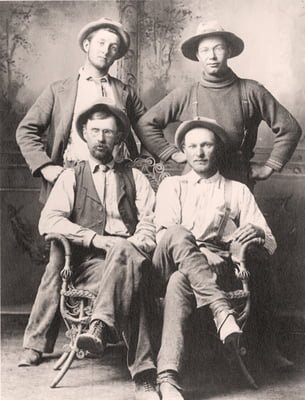
The Homestead Act of 1862 brought the first wave of settlers to the Little Thompson Valley in the late 1860s. James Eaglin paid $10 to file a patent on a 160-acre homestead in 1866 was the first to “prove up” by remaining for the required five years. Others who followed quickly relinquished their claims but as the 1880s drew to a close the valley was filled with pioneer families that had carved productive farms from the raw prairie.
Lewis Cross, an arrival to the Colorado Territory in 1860, became the father of the community when he staked one of the first homestead claims on the banks of the Little Thompson River in 1873. Across the creek from his homestead dwelling Cross built a small log cabin that served as the community’s first school and church and anchored a tiny settlement that became the shipping point for the farmers’ wheat.

When railroad officials requested the settlement on the Cross homestead be relocated from the river bottom to higher ground, the tiny burg was moved a short distance north to a new town site platted on Peter Turner’s homestead.
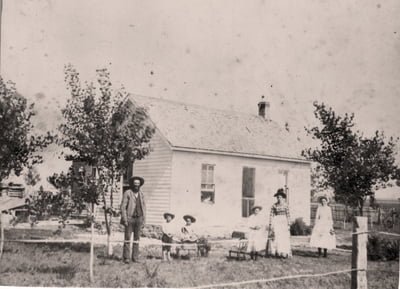
Among the other early homesteaders of the Little Thompson Valley were Patrick Burnside, Carey Culver, W.R. Blore, Charles Meining, Stephen Preffer, S.S. Osborn, Simon Bennett, Davis Baxter, C.V. Stryker, James Bradley, Chalmon Wray, C.R. Skinner, William Flora, Mary Cole, C.C. Clark, Abner Sanderson, W.H. McCormick, Andy Fairbairn, H.K. Hankins, A.A. Knott, J.H. Welty, Fred Bein, O.J. Smith, Phebe Knapp, C.F.W. Beeler, James Taylor and George Wilson.

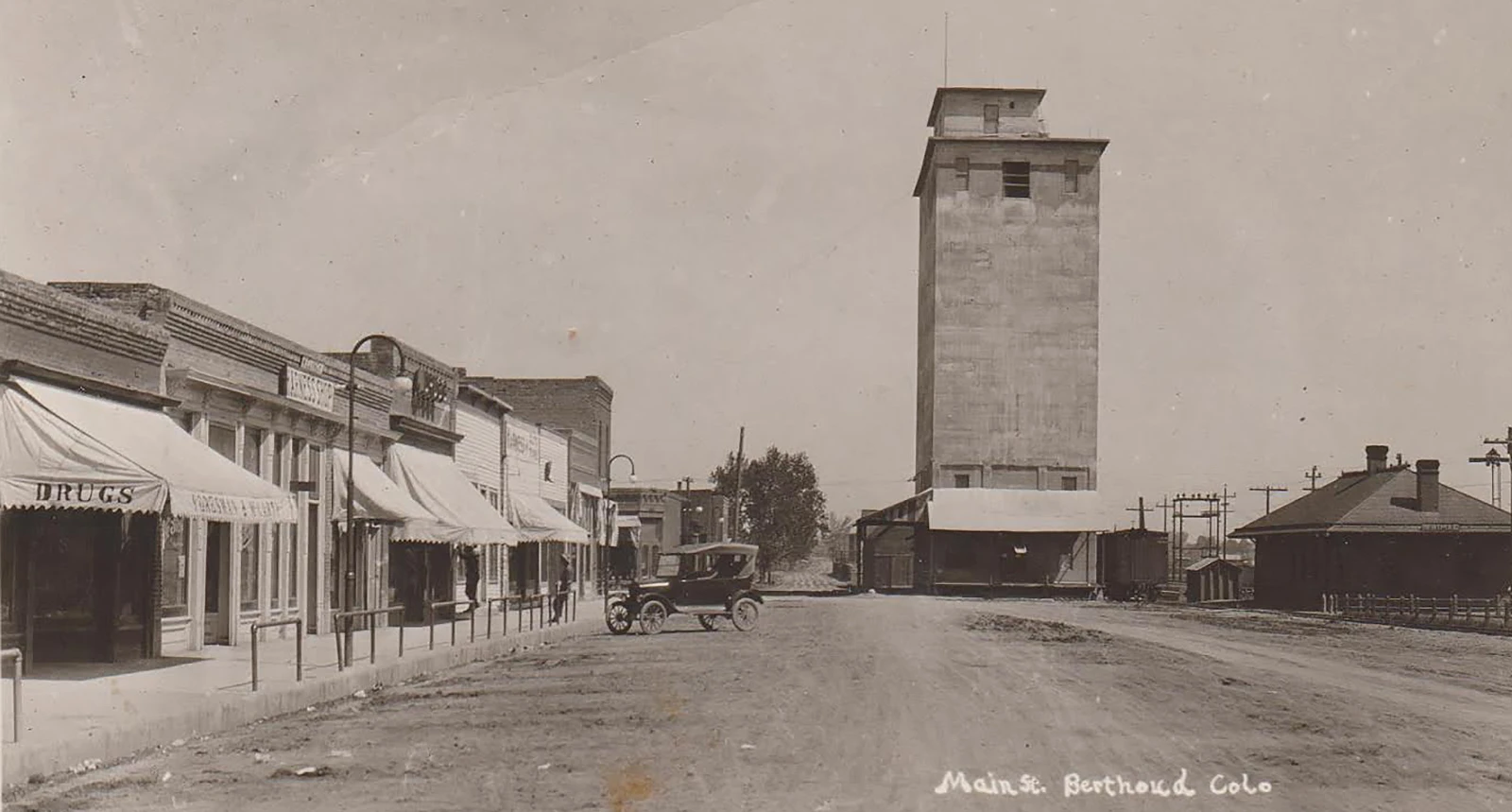
Bountiful wheat harvests in the Little Thompson Valley led Denver businessman J.K. Mullen of the Colorado Milling & Elevator Company to build a grain elevator in Berthoud in the fall of 1885. Two years later in the winter of 1887-88 when the Berthoud Farmers Milling & Elevator Company was incorporated, the elevator was purchased from Mullen with plans to add a flour mill.

Completed in the fall of 1888 at a cost of $52,000, the new mill produced Crown Patent, Farmers Pride, Extra Fancy and Blue Ribbon brand flours at the rate of 300 sacks per day. To meet demand the factory operated around the clock until 10-12 boxcar loads of flour-filled barrels, boxes or sacks had been warehoused.
Re-purchased by J.K. Mullen in 1903, the flour mill was town’s only factory from the 1880s to the 1940s. The mill which was located east of the railroad tracks on Berthoud’s Mountain Avenue was razed in 1966 after it was declared a local fire hazard.
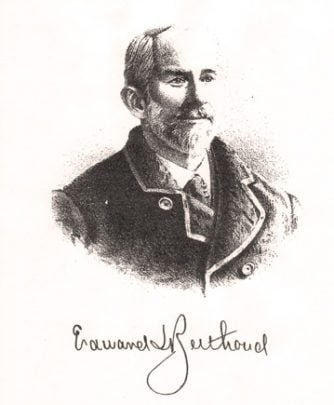
Berthoud takes its name from Capt. Edward. L. Berthoud (1828-1898) who surveyed the route of the Colorado Central Railroad through the Little Thompson Valley and Northern Colorado. Berthoud Pass on the Continental Divide west of Denver also takes its name from the Swiss-born engineer who was on the first faculty of the Colorado School of Mines in 1872.

Eleven-year-old Floyd Clymer (1895-1970) was heralded as the “kid auto agent” when he began selling Reo automobiles in Berthoud in 1906. A daring driver, Clymer attempted to scale Longs Peak on a motorcycle as a young man. Clymer became one of the first historians of primitive American automobiles and built a publishing empire based on car magazines and manuals.

Peter Turner (1838-1912) founded Berthoud at its present-day site after coming to the Little Thompson Valley from the Sunshine mining camp in 1877. Affectionately known to local residents as “Uncle Peter,” Turner supervised the boring of a tunnel that brought water from the Big Thompson River to the Little Thompson Valley via the Handy Ditch in 1883.

The first tracks laid across the Little Thompson Valley in 1877 helped the Colorado Central Railroad connect its line between Longmont, Colorado and Cheyenne, Wyoming. At the Berthoud settlement on the Little Thompson river bottom, the company built a house for its section crew and derailed a boxcar to serve as a makeshift depot.
When it was discovered that locomotives had difficulty generating power to ascend from the river bottom, officials let it be known that the town would be relocated to higher ground or the train would no longer stop in the area. To accommodate the railroad the town was moved in the winter of 1883-84.

At the town’s new site rail sidings branched to grain elevators and a flour mill that anchored a downtown business district served by passenger and freight trains operated by the Colorado & Southern Railroad.
Berthoud maintained a contentious relationship with the railroad that came to light in 1905 when the local tabloid complained, “It seems almost a waste of time to say anything about the condition of the depot waiting room in Berthoud. It is a disgrace to the town. The C. & S. Railway owes it to this community to provide comfortable quarters for its patrons, but as it is there is not enough room to accommodate more than half a dozen people. Ladies who are unfortunate enough to have to wait on a train will not go into the dingy waiting room provided for the public. They are forced to wait in nearby stores until the train comes in sight, and then run for it. It is so seldom that a C. & S. train arrives on time that a decent waiting room is necessary.”
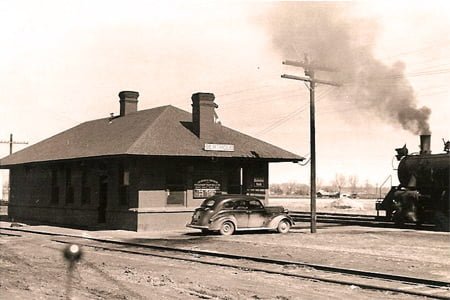
Passenger service continued into the 1940s but gave way to freight trains operated by the Burlington Northern and Santa Fe (BSNF Railway) that continue to use the railroad today.

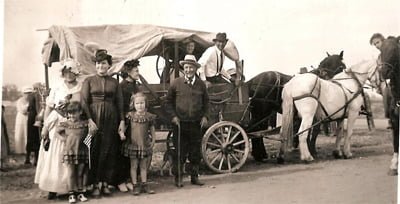
The first wagon road through the Little Thompson Valley was established in 1850 when a party of Cherokee Indians traveling from northeast Oklahoma to the gold fields of California crossed the upper reaches of the Little Thompson Valley. Led by Capt. Edmonson, guided by mountain man Ben Simon, and chronicled by diarist James Mitchell, the “party camped up in the edge of the mountains on little creek running east, the water cold from the Snow.”
Twelve years later in 1862 Ben Holladay altered the route of his Overland Stage line to run north from Denver to Laramie. The result was a stagecoach road that roughly paralleled the trail the Cherokee party followed in 1850, but located a few miles east in the vicinity of present-day Colorado State Highway 287. Holladay also established a “swing station” on the banks of the Little Thompson River where stagecoaches stopped to change horse teams.
In 1937 the Pioneers of the Little Thompson, a self-described group of “men and women who blazed the trails,” placed a granite marker on Highway 287 southwest of Berthoud to mark the vicinity of the Overland stage road crossing of Little Thompson creek. The monument was later removed to Berthoud Town Park where it still stands.

By 1914 the Lincoln Highway followed a corridor through Northern Colorado similar to that of the Overland Trail. Crossing Little Thompson creek near the ford of the old stage road crossing, The Berthoud Bulletin opined, “The Lincoln Highway is at present no credit to the gentleman for whom it was named. The people who travel it during the week are not in a right frame of mind to go to church Sunday.”

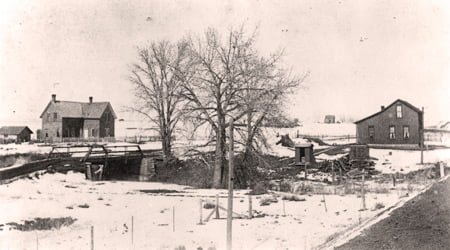
Originally home to nomadic bands of the Arapaho, the Little Thompson River Valley became the domain of the white man in the 1860s when new arrivals to the Colorado Territory turned their attention from nearby mining districts to homestead claims along the river.
Among these early homesteaders was Lewis Cross who became postmaster of the “Little Thompson” post office in 1875. In 1877 when the Colorado Central Railroad laid tracks across the Little Thompson River and beside the Cross ranch, the small settlement on Cross’s homestead informally known as Little Thompson was named Berthoud in honor of Capt. E.L. Berthoud who had surveyed the rail route through the region.
Berthoud remained at its river bottom location until the railroad company requested the town be moved to the bluff to the north where homesteader Peter Turner had platted a new town site. When the town was relocated in the winter of 1883-84 it took the name Berthoud with it and the original settlement became known as “Old Berthoud.”

At its new location Berthoud began to grow into a lively agricultural center of southern Larimer County. Within a few years the town stretched for three blocks along the railroad tracks and boasted a small business district, flour mill and residential neighborhoods containing 200 residents.